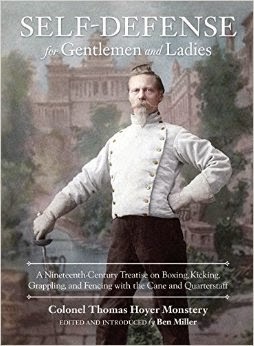Title: Self-Defense for Gentlemen and Ladies
Edited by : Ben Miller
Publisher: Blue Snake
Format: Hardback
Page Count: 199
Cover Price: $14.95 (USD)
Let me first say that I am in favor of inclusion of HEMA (Historical European Martial Arts) in our little martial arts family. Its a weird kind of reverse racism that says "martial arts can only come from Asia." Especially when its being said by a person of European decent in America. Do you get the joke? In rare occasions, we have historical fencing being practiced with a direct lineage back farther than some of the Asian martial arts. The Martinez Academy in New York City is a prime example of this. However, just before the turn of the last century there were actually many people, in many American cities teaching different lineages of different combat systems, both armed and unarmed. The most colorful of these characters has to be Col. Thomas Hoyer Monstery. That's what this book is; a combination of a biography and collection of his teachings.
Content
The book is really divided into two parts. It starts off with a biography of the Danish born American, Col. Thomas Hoyer Mostery. This man had the type of adventurer life that only seems possible in the Victorian age. He learned various forms of swordsmanship and fencing as a youth, was involved in at least 50 duels, fought under 12 different flags and achieved the rank of colonel. If anyone is going to read this, I don't want to spoil the anecdotal stories about him, because they're that good.
The second half of the book is a collection of newspaper articles which detail his methods of combat. The first couple chapters are collections of unarmed combat, which he calls boxing, but it includes things like trips, sweeps, and how to escape headlocks, so its much more than the sport boxing that we think of today. He then continues on with his weapons techniques including cane, swords of various types including foil, rapier, and saber, and concluding with staff techniques and drills.
The second half of the book is a collection of newspaper articles which detail his methods of combat. The first couple chapters are collections of unarmed combat, which he calls boxing, but it includes things like trips, sweeps, and how to escape headlocks, so its much more than the sport boxing that we think of today. He then continues on with his weapons techniques including cane, swords of various types including foil, rapier, and saber, and concluding with staff techniques and drills.
Pros
To be honest, just the biography at the beginning would be worth the price of admission This guy was a gentleman badass in the truest sense of the word. I wanted to go and look up more on this guy, whom I had never heard of before this, just from the introduction. Besides that, this book contains a wealth of information on a lineage of martial arts that most people, that are going to be reading this, have more in common with culturally than the Asian martial arts. There is a rich heritage of fighting arts from Europe that made its way across the Atlantic with many of America's (and I assume Canada's) immigrants.The chapters by Col. Monstery are surprisingly well written, and can still be followed very easily. With a little bit of practice, I think they can be very easily worked out what the techniques are, and what the principles behind them are. With my background in Asian martial arts, I could easily follow the descriptions and illustrations. Especially the staff section, as it shows how transferable this knowledge is.


This comment has been removed by the author.
ReplyDeleteYou will learn self defense techniques that can be incredibly useful in a life or death situation. And very simple to Learn!
ReplyDelete